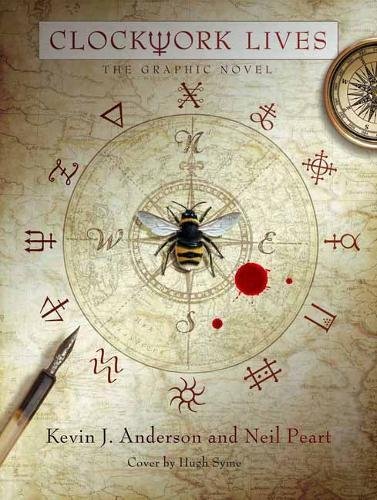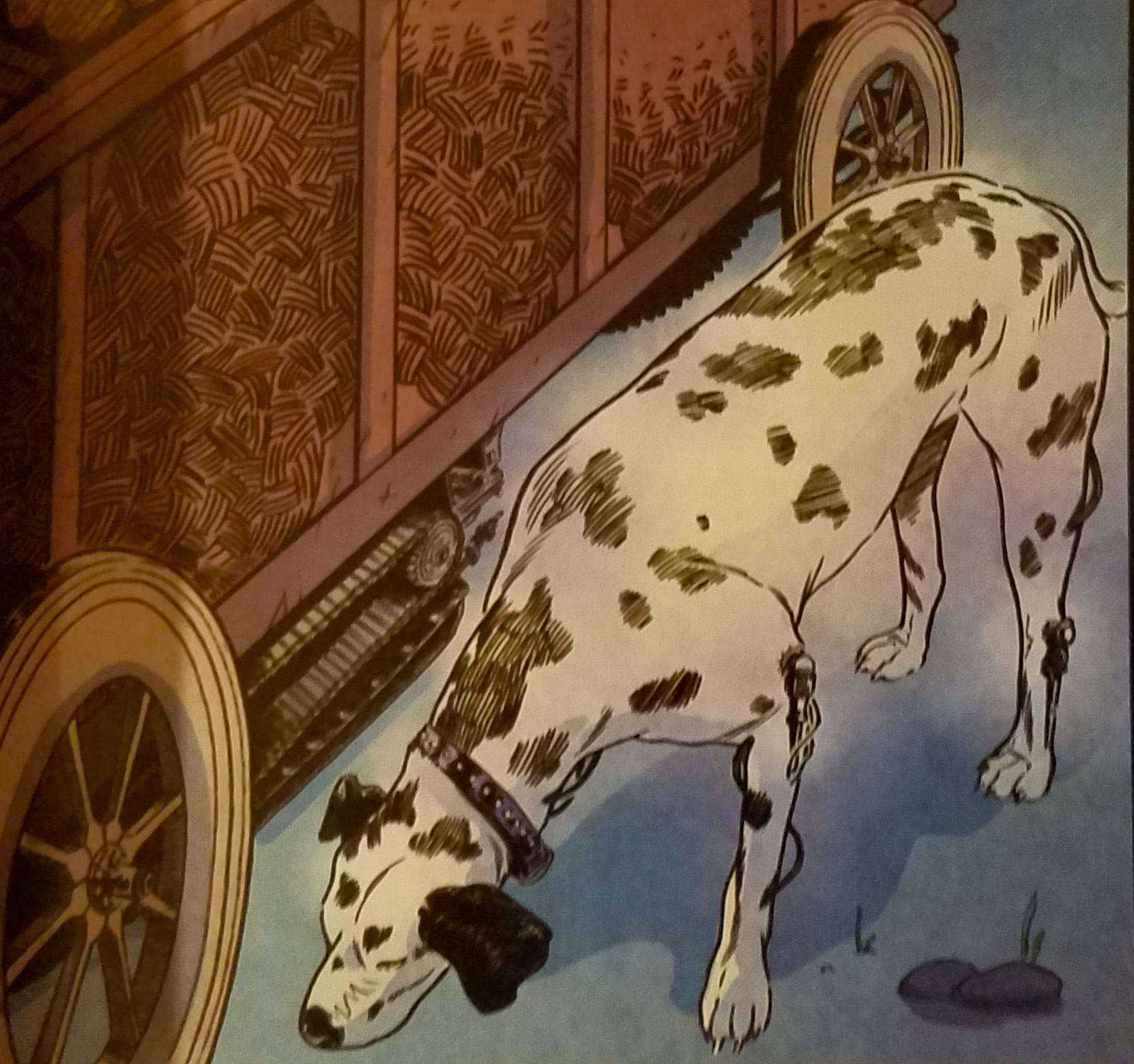 |
The Graphic Novel Book Review by John Patuto June 2018 |
When Neil Peart first put pen to paper nearly a decade ago, one has to wonder if he envisioned just how far-reaching his Clockwork Universe would become. It began with the 12-part epic Rush album Clockwork Angels which, through imaginative lyrics and progressive-infused music, told the story of protagonist Owen Hardy's quest to follow his dreams in a lavish and colorful world of steampunk and alchemy. After the release of the album, Owen Hardy’s exploits were expanded into a full-length novel, collaboratively written by award-winning novelist Kevin J. Anderson, and Neil Peart.
 Several years later, a graphic novel representation of the Clockwork Angels novel was produced, bringing to life the imagery that Peart and Anderson had created in their steampunk world. But the story didn’t end there. Anderson and Peart joined forces again in 2015, authoring a new adventure set in the Clockwork Universe: Clockwork Lives. The follow-up novel tells the story of Marinda Peake, a woman who sacrificed everything in order to take care of her aging and ailing father. For years, Marinda follows a daily schedule that dictates her life, and she adheres to it with tenacity. She does not look upon her care-giving life as a burden. Instead, she celebrates in the clockwork stability of her role, preferring logic over flights of fancy. She has everything she needs in the modest home she shares with her father, and has no desire to venture beyond her small town. However when Marinda’s father passes away unexpectedly, her entire world is turned upside down.
Several years later, a graphic novel representation of the Clockwork Angels novel was produced, bringing to life the imagery that Peart and Anderson had created in their steampunk world. But the story didn’t end there. Anderson and Peart joined forces again in 2015, authoring a new adventure set in the Clockwork Universe: Clockwork Lives. The follow-up novel tells the story of Marinda Peake, a woman who sacrificed everything in order to take care of her aging and ailing father. For years, Marinda follows a daily schedule that dictates her life, and she adheres to it with tenacity. She does not look upon her care-giving life as a burden. Instead, she celebrates in the clockwork stability of her role, preferring logic over flights of fancy. She has everything she needs in the modest home she shares with her father, and has no desire to venture beyond her small town. However when Marinda’s father passes away unexpectedly, her entire world is turned upside down.
When her father’s will is read, her anticipated inheritance of his home and wealth, accumulated under the employment of the Watchmaker years earlier, was provisional. She was handed a large, blank journal filled with alchemically-treated pages. When a drop of blood was deposited on a page, a person’s life story, whether uneventful or epic, would magically be inscribed. In order for Marinda to receive the remainder of her inheritance, her father stipulated that she needed to explore the world outside of her hometown, collecting enough stories to fill her book; a book of Clockwork Lives. The very first story for the journal is that of her father, which sets the stage for the intertwined journeys and adventures that Marinda would undertake to satisfy her father’s final wishes.
“…at first you will hate me for this…and then you will love me for it…”
To build on the success of the Clockwork Lives novel, Anderson, Peart, and a team of artists developed Clockwork Lives: The Graphic Novel, a lavishly illustrated, and gorgeously bound book that brings the adventures of Marinda to life. Anderson joined forces with Insight Editions to develop the graphic novel and, as he explains in the book’s introduction, they came up with ”…a unique plan to have one artist for the overall Marinda frame story and different artists for the individual tales, reflecting the[ir] individual styles…”.
The book itself is handsomely crafted in an oversized, high-quality hard-cover bound. The cover artwork, courtesy of Hugh Syme, is absolutely stunning while the heavy stock glossy pages allow the artwork to truly shine. In addition to the thirteen individual chapters, the graphic novel includes a foreword by Matt Scannell, founding member and lead singer/guitarist of the alternative rock band Vertical Horizon, a preface by Hugh Syme, and introduction by Kevin J. Anderson, and an afterword by Doane Perry of Jethro Tull.
 In the original novelization of Clockwork Lives, each epic story was preceded by a singular, detailed drawing which gave the reader some visual insight into the tale that was about to unfold. The rest of the visualization was left to the reader’s imagination. With the graphic novel adaptation, the use of different artists instilling their own unique style into each story brought each character, each event, each location to life in a way that was varied and unpredictable. The individual artistic stylings of each story were threaded together seamlessly into the overall tapestry of the book. The diverse imagery lent itself beautifully to each story, from the dark and foreboding artwork reflected in The Steamliner Pilot’s Tale, to the energetic and colorful imagery in The Percussor’s Tale, to the striking use of shading and red-tones in The Seeker’s Tale. From panel to panel, from tale to tale, the reader is greeted with vibrant, soulful illustrations that perfectly capture the essence of each Clockwork life.
In the original novelization of Clockwork Lives, each epic story was preceded by a singular, detailed drawing which gave the reader some visual insight into the tale that was about to unfold. The rest of the visualization was left to the reader’s imagination. With the graphic novel adaptation, the use of different artists instilling their own unique style into each story brought each character, each event, each location to life in a way that was varied and unpredictable. The individual artistic stylings of each story were threaded together seamlessly into the overall tapestry of the book. The diverse imagery lent itself beautifully to each story, from the dark and foreboding artwork reflected in The Steamliner Pilot’s Tale, to the energetic and colorful imagery in The Percussor’s Tale, to the striking use of shading and red-tones in The Seeker’s Tale. From panel to panel, from tale to tale, the reader is greeted with vibrant, soulful illustrations that perfectly capture the essence of each Clockwork life.
The novelization of Clockwork Lives is vast, containing nearly 400 pages of the detailed exploits of Marinda and her journeys. Condensing her adventures down into a graphic novel format was no doubt challenging for the authors and artists alike, but their translation of the novel into the visual medium was unquestionably successful. As I worked my way through this impressively bound book, I often paused at various panels, recalling those details from the novel and appreciating how the imagery filled in much of the blanks. I found my own imagination wafting through the streets of Crown City, exploring the nooks of the Under World book store, or taking in a pint at the Cygnus tavern. As Doane Perry of Jethro Tull fame reflected in the book’s afterword, the artists ”…breathed these characters into three-dimensional existence within a two-dimension platform, vibrantly infusing life and character into them…both artful and playful…”.
 And it is that playful creation of both the characters and the scenery that will be of particular interest to Rush fans. The graphic novel is filled with nods, both obvious and subtle, to the Canadian group. The aforementioned Cygnus Tavern brought a broad smile to my face, for obvious reasons. While the clever use of lyrical phrases from numerous Rush songs were always a treat to encounter. After reading through the graphic novel, I went back and studied the artwork more closely, which uncovered many more Rush references. Again, some obvious like the appearance of all three band members in The Percussor’s Tale, to the less obvious appearance of the Snakes & Arrows curved arrow sign sitting next to the Fly By Night owl in The Seeker’s Tale. Returning to the novel during a future reading will doubtless reveal other Rush nuggets.
And it is that playful creation of both the characters and the scenery that will be of particular interest to Rush fans. The graphic novel is filled with nods, both obvious and subtle, to the Canadian group. The aforementioned Cygnus Tavern brought a broad smile to my face, for obvious reasons. While the clever use of lyrical phrases from numerous Rush songs were always a treat to encounter. After reading through the graphic novel, I went back and studied the artwork more closely, which uncovered many more Rush references. Again, some obvious like the appearance of all three band members in The Percussor’s Tale, to the less obvious appearance of the Snakes & Arrows curved arrow sign sitting next to the Fly By Night owl in The Seeker’s Tale. Returning to the novel during a future reading will doubtless reveal other Rush nuggets.
Clockwork Lives leads with a simple declaration: Some lives can be summed up in a sentence or two. Other lives are epics.. The graphic novel’s visual representation of these lives, both simple and epic, brings justice to both. Watching the evolution of Marinda’s simple sentence-style life, to the discovery of her own unwritten epic, with revelations about her father, and her carefree mother makes the graphic novelization a perfect companion to the Clockwork Lives novel.
As I closed the book after my third reading, I was left wondering what a single drop of my blood would reveal in Marinda’s alchemically-treated journal. Would the story be only a few short, simple sentences, or would it unfold into an epic tale?
Time will tell.
Thanks, as always, for reading.
-John
Puchase
Clockwork Lives: The Graphic Novel at Amazon.Com


